If you enjoy solving puzzles and want a fun way to sharpen your mind, then an IT Wordsearch is the perfect activity for you. Unlike traditional word games, this puzzle is designed around technology-related terms, making it both entertaining and educational. Whether you are a beginner exploring puzzle-solving basics, a student learning computer science vocabulary, or simply someone looking for a quick brain training activity, IT Wordsearch offers the right balance of challenge and enjoyment.
It can be played as a word finding activity for kids, used as part of educational resources, or even added to classrooms as a creative learning tool. With its simple format and engaging structure, IT Wordsearch helps improve focus, memory, and problem-solving skills while making learning about IT fun. This guide will walk you through everything you need to know—from rules to tips—so you can enjoy solving and even creating your own puzzles.
What Is an IT Wordsearch?
An IT Wordsearch is a special type of puzzle designed around IT-related words and technology terms. Unlike a regular word search, which may use random themes like animals, countries, or food, this version focuses on computer science vocabulary. You’ll find hidden words from areas like coding, networking, cybersecurity, and software development arranged in a grid. The goal is simple—spot the words and circle or highlight them—but the learning value is far greater.
Think of it as a mix between a fun puzzle and a tech education tool. For beginners in computer science, it becomes an interactive way to study tech concepts. For example, a puzzle might include terms such as “firewall,” “Python,” or “router.” By searching and recognizing these words repeatedly, learners strengthen their understanding of digital terms—just like how kids memorize spelling words in school.
Teachers and trainers often use an IT Wordsearch puzzle as a brain game for IT learners. It’s engaging because it feels like play rather than study, yet it reinforces real knowledge. A game for practicing computer vocabulary can also help adults new to tech, such as professionals transitioning into IT roles or students starting digital literacy programs.
What makes it unique is that it doesn’t just test your eyes—it sharpens your memory, focus, and problem-solving skills while exposing you to tech-related vocabulary lists. Imagine a beginner who knows nothing about “encryption.” After spotting it several times in software-related puzzles, the term feels more familiar and less intimidating.
To put it simply, an IT Wordsearch is a tool for learning digital terms in a way that’s engaging, simple, and effective. Whether you’re a student, a teacher, or a casual learner, it offers a fun introduction to computer science vocabulary while giving your brain a good workout.
A Brief History of Word Search Games
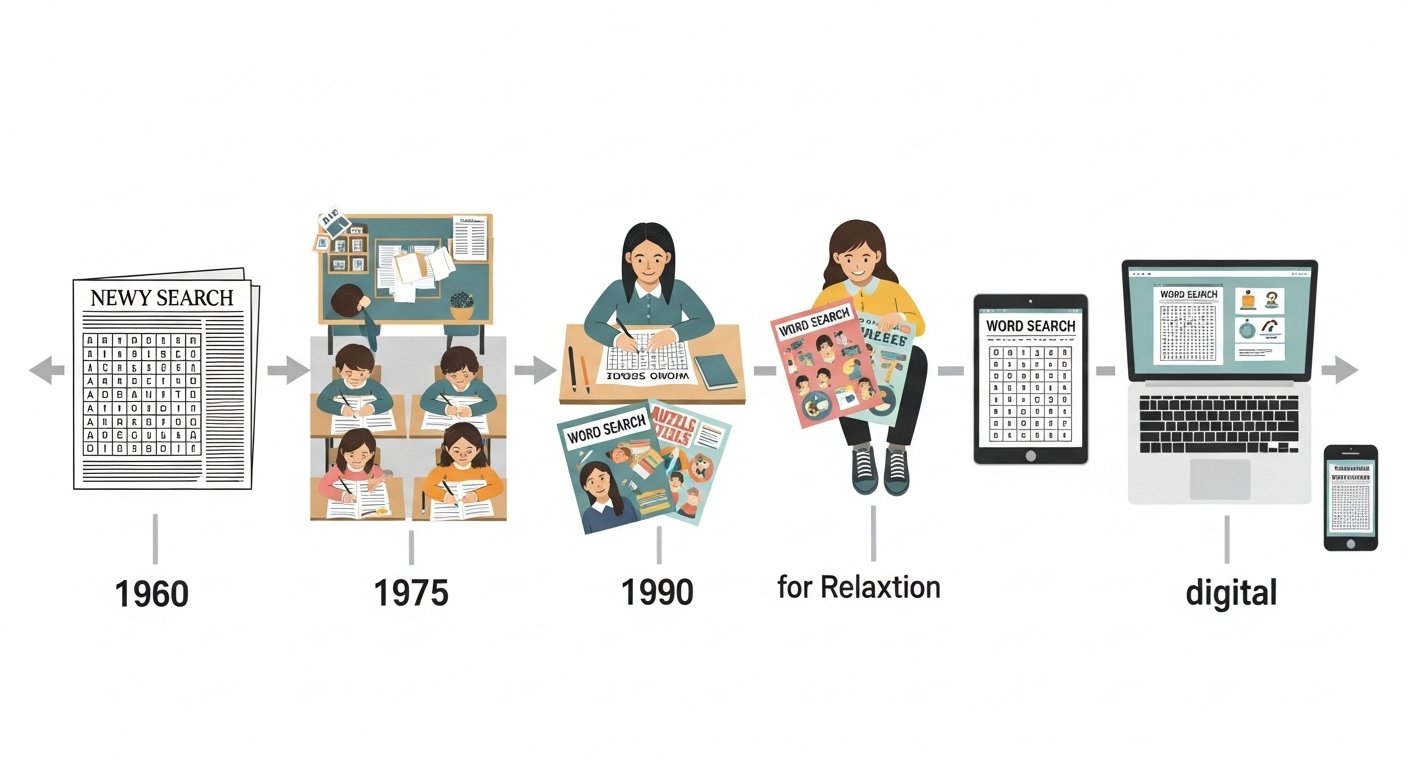
Before the IT Wordsearch became popular, word search puzzles had a long and fascinating journey. The origin of word search puzzles goes back to the late 1960s in the United States. In 1968, Norman E. Gibat, often credited as the first word search creator, published the puzzle in a local newspaper in Norman, Oklahoma. It was meant as a simple pastime, but the idea spread quickly across the country.
The history of word games shows how quickly they evolved from being just a novelty to becoming part of everyday life. Teachers discovered that these traditional educational puzzles could help students improve vocabulary and spelling. By the early 1970s, publishers began including them in puzzle magazines in the USA, and they soon became one of the most recognizable formats of paper-based puzzle games.
As the decades passed, word searches became more than just entertainment. Their cultural impact was clear—they appeared in classrooms, newspapers, and even waiting rooms. Students were learning spelling while adults used them for stress relief. This was the beginning of the evolution of puzzles, where they moved from fun activities into early educational puzzle formats.
With the rise of computers and the internet, word searches didn’t disappear—they transformed. The evolution from print to digital puzzles brought interactive online versions, mobile apps, and custom generators. This shift also allowed the development of themed word searches, like science-based, language-based, or technology-based puzzles. Today, we even see specialized versions such as the IT Wordsearch, which blends learning with modern tech vocabulary.
The timeline of word search development shows a steady rise from small-town newspaper columns to a global phenomenon. What started as a traditional word puzzle has now become an adaptable tool for education, entertainment, and even workplace training.
Why IT Wordsearch Is Popular and Beneficial
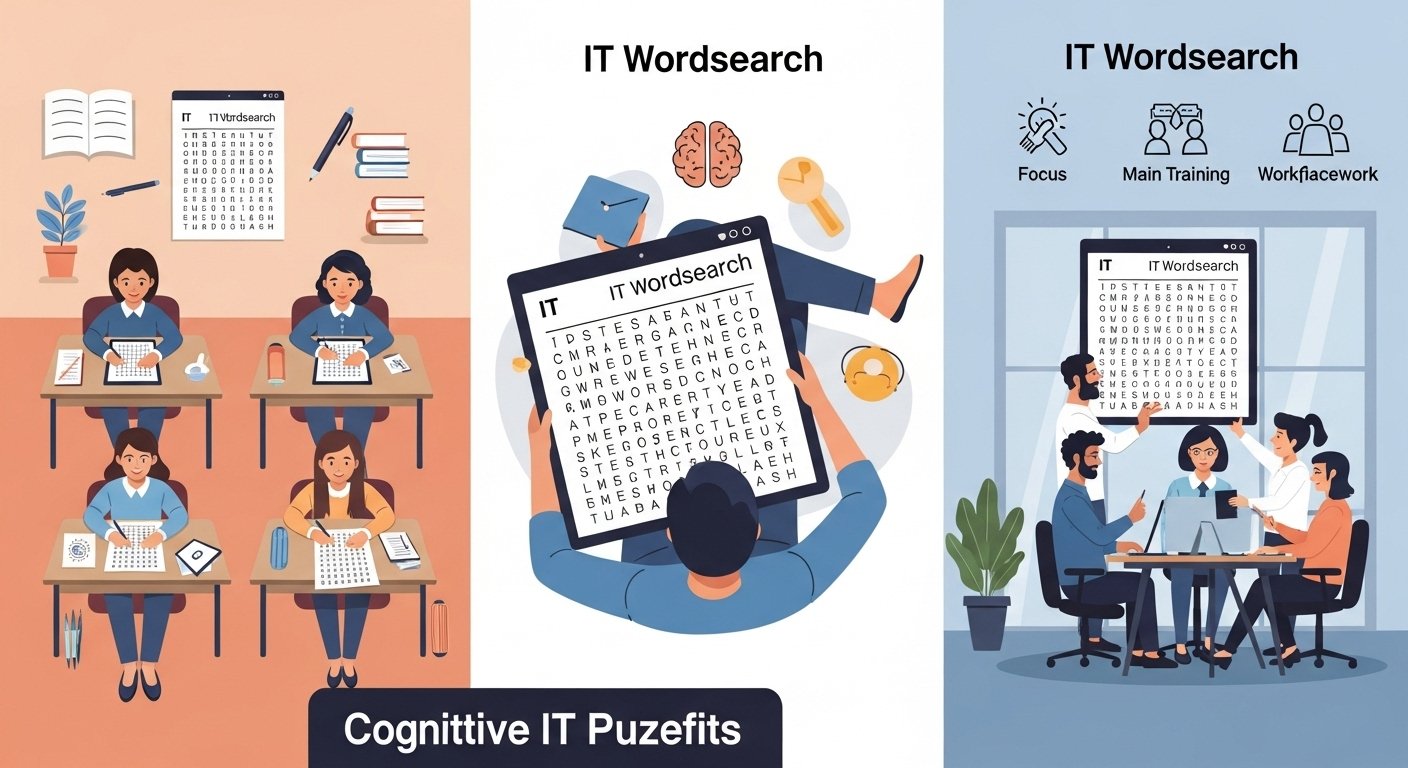
The IT Wordsearch is more than just a fun puzzle. It has become a valuable tool in classrooms, workplaces, and personal learning because it combines entertainment with real educational and cognitive benefits. From student-friendly learning games to team-building activities, these puzzles provide an engaging way to strengthen both knowledge and mental skills.
Educational Value
One of the biggest reasons the IT Wordsearch is popular is its strong role in education. Teachers use it as part of classroom puzzle activities to make lessons more interactive. For example, instead of memorizing terms from a textbook, students might search for “algorithm,” “server,” or “encryption” in a puzzle grid. This hands-on method turns abstract technology concepts into a fun way to teach IT.
In STEM-focused schools, these puzzles act as digital classroom activities that enhance IT literacy exercises. A student solving them repeatedly builds familiarity with important terms, making it easier to retain and recall definitions. It’s not just a tool for student vocabulary retention—it’s also a way to keep learners excited and engaged.
Educators also appreciate the flexibility. An IT Wordsearch can be used as part of educational puzzle worksheets, group work, or even as academic puzzle resources for homework. It fits well into interactive education methods, supporting teachers in boosting engagement in classrooms while providing students with an easy tech-based learning activity.
Cognitive and Mental Benefits
Beyond the classroom, solving an IT Wordsearch strengthens the brain. Like other memory improvement activities, it helps with focus, attention, and mental agility. Spotting hidden words across a grid may seem simple, but it actually trains the brain to recognize patterns, improve scanning ability, and think strategically.
These puzzles are often used as stress-relief games because they encourage concentration while also being relaxing. Many people find them similar to meditation—your mind stays focused on one task, blocking out distractions. That’s why psychologists often recommend such therapeutic puzzle benefits for people who want to unwind while keeping their brain active.
Students and adults alike gain from these cognitive stimulation activities. A person solving an IT Wordsearch improves problem-solving, enhances memory, and develops stronger logic and reasoning skills. In fact, many consider it a type of brain training exercise that supports long-term mental wellness.
Professional and Workplace Use
In the workplace, the IT Wordsearch has become a creative way to combine learning with fun. Companies often use it as part of team-building activities or corporate training exercises. For example, new employees might solve puzzles containing terms from company software, cybersecurity policies, or industry jargon. This makes onboarding both interactive and memorable.
HR managers and trainers also use ice-breaker puzzles to kick off meetings or workshops. These activities serve as gamification for employee learning, boosting engagement while still being productive. Employees not only refresh their knowledge of tech training resources but also enjoy a moment of light-hearted collaboration.
Even beyond training, these puzzles support professional development activities by keeping IT vocabulary sharp. In a fast-moving tech world, refreshing digital literacy through puzzle-based employee engagement is an innovative approach. Plus, the activity doubles as a stress reliever, making it useful for workplace mental wellness programs.
Different Types of IT Wordsearch Puzzles
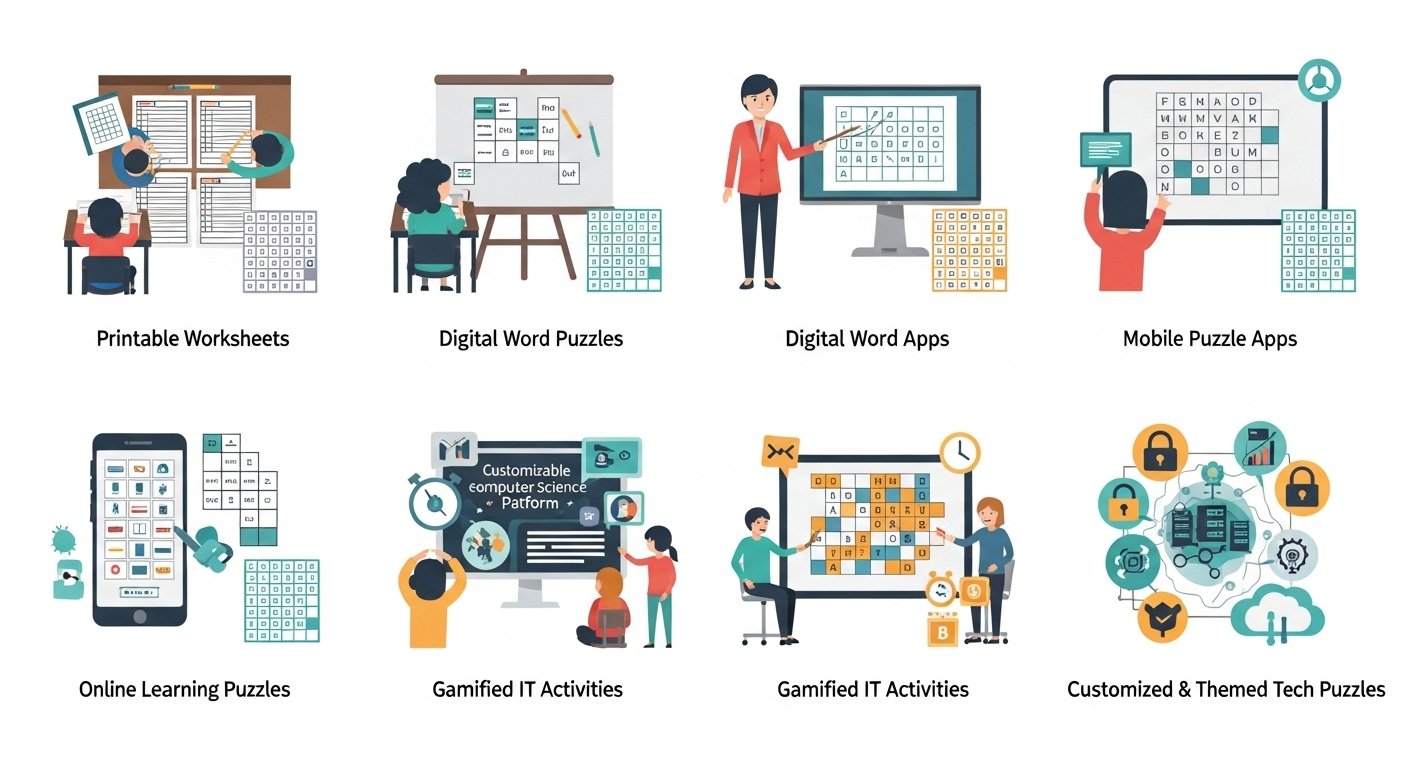
The IT Wordsearch comes in many forms, making it flexible for students, teachers, and even professionals. Over the years, different word search formats have evolved to fit both digital learning environments and traditional paper-based classrooms. Each type has its own advantages, depending on the learner’s goals and setting.
1. Printable Worksheets
The classic form of an IT Wordsearch is still the paper version. Teachers often hand out printable worksheets in classrooms, making them perfect for offline use. These offline puzzle sheets allow students to circle or highlight terms such as “cloud,” “network,” or “encryption.” The format works well in group activities or homework tasks, and it is especially popular in schools with limited digital access.
2. Digital Word Puzzles
With the growth of online education, digital word puzzles are now widely used. These are interactive versions that can be played on laptops, tablets, or smartboards. They are great as digital classroom puzzle versions because teachers can display them during lessons or share them through online platforms. Students find these engaging since they can click, drag, and highlight words instantly.
3. Mobile Puzzle Apps
For learners on the go, mobile puzzle apps offer convenient access to mobile-friendly puzzle games. These apps often include tech-themed puzzle categories like coding, software, or cybersecurity. The best part is that users can play them anytime, whether on the bus, at home, or during a study break. Some apps also include leaderboards, turning learning into a competitive and fun challenge.
4. Online Learning Puzzles
Platforms that focus on online learning puzzles provide customizable puzzles for schools and teachers. These allow instructors to create puzzles using specific IT vocabulary lists—for example, a puzzle on networking for computer science students. They’re also great for distance learning because puzzles can be shared easily via links or classroom management tools.
5. Gamified IT Activities
Modern educators and trainers love using gamified IT activities. These puzzles often come with points, timers, or badges, which motivate learners to complete challenges faster. For instance, a group puzzle format might ask teams to find as many IT-related terms as possible in under 5 minutes. This approach blends competition with learning, which works well in both classrooms and workplace training.
6. Customized and Themed Tech Puzzles
Finally, there are customized word searches designed for specific purposes. A teacher might design one for cybersecurity terms, while a company might create a puzzle for onboarding new IT staff. These themed tech puzzles make learning more relevant and engaging because they focus only on the terms learners need to know.
Quick Comparison of IT Wordsearch Formats
| Puzzle Type | Best For | Key Advantage | Example Use Case |
|---|---|---|---|
| Printable Worksheets | Classrooms, offline learners | Easy to use, no devices needed | Homework, group classroom activity |
| Digital Word Puzzles | Online classes, e-learning | Interactive and engaging | Teacher-led digital lessons |
| Mobile Puzzle Apps | Individual learners, casual practice | Convenient and portable | Study on the go, personal brain games |
| Online Learning Puzzles | Schools, remote education | Customizable for specific IT topics | Cybersecurity or coding vocabulary |
| Gamified IT Activities | Group learning, corporate training | Competitive and motivating | Team-building or training sessions |
| Customized/ Themed Puzzles | Specialized learning needs | Tailored to unique vocabulary | Onboarding or niche tech courses |
How to Play an IT Wordsearch Puzzle
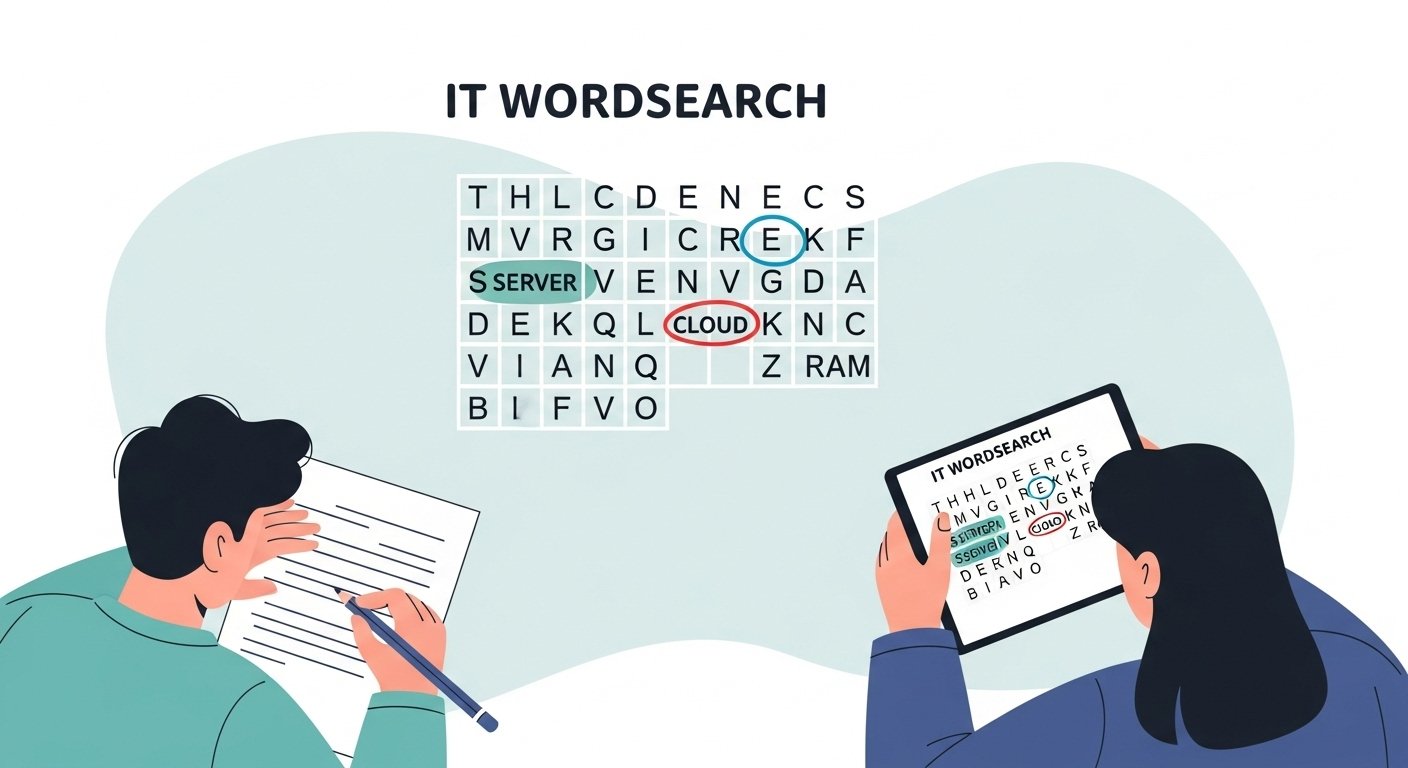
If you’re new to an IT Wordsearch, don’t worry—it’s one of the easiest and most enjoyable word finding activities you can play. The rules are simple, and with a little practice, anyone from children to adults can solve these puzzles quickly. Whether you’re doing it for fun, study, or brain exercise, learning the puzzle-solving basics is the first step.
Step-by-Step Guide to Playing an IT Wordsearch
Understand the Puzzle Grid
Every IT Wordsearch puzzle comes with a grid filled with random letters. Alongside the grid, you’ll see a list of technology-related words you need to find, such as “server,” “algorithm,” or “firewall.” These words are hidden in all directions—horizontally, vertically, diagonally, and sometimes even backward.Start with Easy Words
For beginners, it’s best to begin with shorter or unique words, such as “RAM” or “IP.” This makes the puzzle-solving steps easier and builds confidence. Kids especially enjoy this method because it feels like a treasure hunt where the first clues are easy wins.Scan Line by Line
Use your eyes to scan each row or column carefully. This strategy helps you spot patterns instead of jumping around randomly. It’s a simple but effective puzzle strategy for first-timers.Circle or Highlight the Words
Once you find a word, circle it (on paper) or highlight it (digitally). Marking the words keeps you from searching for the same word twice and gives you a sense of progress as the grid becomes clearer.Check All Directions
Many beginners only look left to right. But hidden words may run backward, diagonally, or vertically. Teaching kids to check all directions is part of a good children’s puzzle guide because it makes them more observant.Finish the Word List
The goal is to find every term in the given list. Some puzzles also include “bonus” words not listed but still hidden in the grid, which makes the game extra fun for advanced players.
Beginner Puzzle Tips
Start with distinct letters (like “Q” or “Z”) since they stand out.
Use a ruler or your finger to track each line if the grid feels overwhelming.
Break the puzzle into sections and solve one corner at a time.
For teaching kids to solve puzzles, begin with small grids (e.g., 8×8) before moving to larger, more complex ones.
Why IT Wordsearch Is Easy to Learn
The best part about an IT Wordsearch is that there are no complicated rules for playing puzzles. It’s a straightforward step-by-step puzzle guide: find the words, mark them, and complete the list. Unlike other games, there’s no scoring system or penalties—it’s just about observation and focus. That’s why instructions for puzzle activities are often used in classrooms, training sessions, and even family games at home.
Tips and Tricks to Solve IT Wordsearch Faster
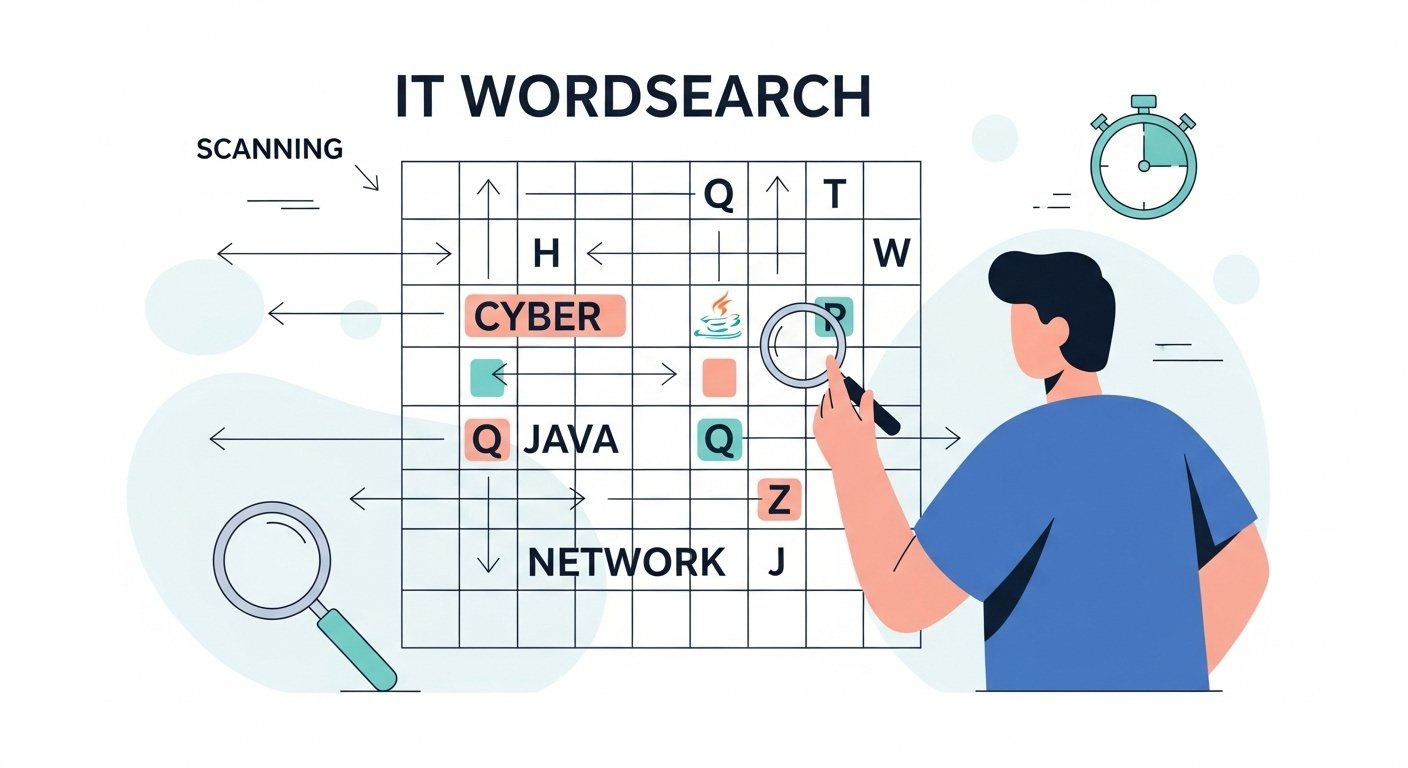
Solving an IT Wordsearch is fun, but sometimes it can feel slow if you don’t have the right approach. The good news is, with a few puzzle-solving strategies and some practice, you can complete grids much faster without missing words. Think of it as training your brain with a set of smart speed-solving puzzles methods that improve both accuracy and efficiency.
1. Start With the Unusual Letters
One of the best tricks to find words faster is to focus on letters that stand out. Words like “quiz,” “cyber,” or “Java” often have unique letters (Q, Z, J, Y) that are easier to spot in a grid. By spotting unusual letter patterns, you can quickly lock onto tricky words that might otherwise be missed.
2. Use Scanning Techniques
Instead of randomly searching the grid, try scanning techniques line by line—horizontally, vertically, and diagonally. Moving your eyes systematically helps you find words faster, much like reading text in a book. Some solvers even use their finger or a ruler to guide their eyes, a simple focus technique for puzzles that prevents distractions.
3. Highlight or Circle as You Go
Marking words as you find them prevents confusion and keeps the grid clear. Many players use the highlighter puzzle method when solving on paper, while digital versions often let you tap and highlight directly. This small step saves time and helps avoid searching for the same word twice.
4. Look for Word Beginnings and Endings
Instead of searching for the entire word, try spotting the first or last letter. For example, when looking for “network,” find all the “N’s” or “K’s” in the grid and then check surrounding letters. This is one of the simplest but most effective puzzle-solving hacks.
5. Break the Grid Into Sections
Large word searches can be overwhelming. A good puzzle-solving shortcut is to divide the grid into smaller sections and complete one at a time. This method reduces errors and increases speed, especially in complex tech-themed word searches.
6. Train With Timed Practice
Like any skill, faster solving comes with practice. Set a timer and challenge yourself to finish a puzzle in record time. These small challenges act as brain training strategies and boost your ability to solve even harder puzzles with ease.
7. Avoid Common Mistakes
Beginners often forget to check backward or diagonal directions, which leads to missed words. Another common mistake is not re-checking partially found words. By being aware of these pitfalls, you can apply expert puzzle tips and become a more efficient solver.
Quick List of Expert Advice for Solving Quickly
Scan systematically instead of randomly.
Focus on rare letters like Q, X, or Z.
Circle or highlight words immediately.
Use word beginnings and endings as clues.
Break large grids into smaller areas.
Practice regularly to build speed.
Creating Your Own IT Wordsearch Puzzle
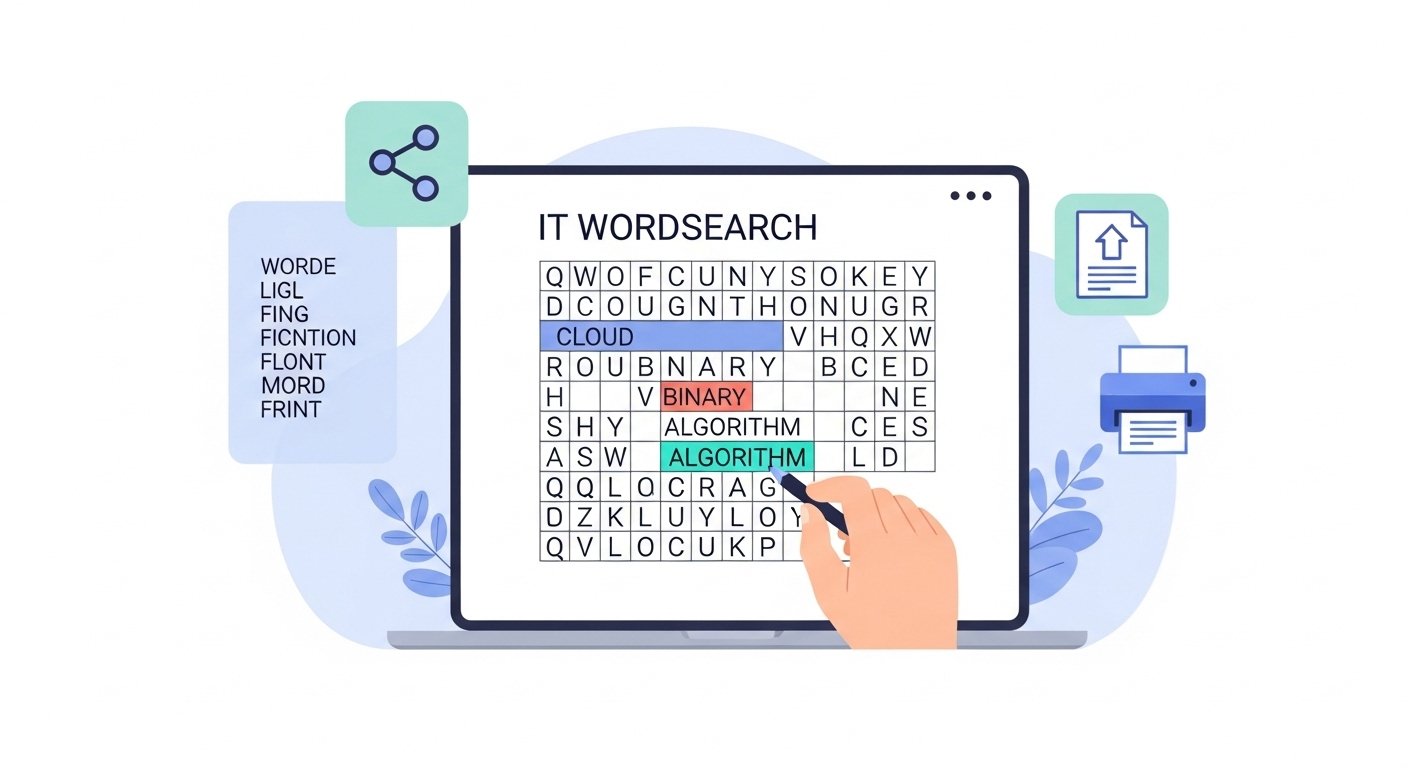
Making your own IT Wordsearch is not only fun but also a great way to combine creativity with learning. Whether you’re a teacher preparing for class, a parent encouraging tech literacy, or a student practicing new terms, designing puzzles can be simple and rewarding. By choosing the right words, using the best tools, and sharing the final product effectively, you can create engaging tech-themed word puzzles that add real value.
Choosing the Right Word List
The foundation of any good IT Wordsearch is the word list. Picking the right terms ensures the puzzle is both educational and enjoyable. You can build your list from technology word banks, coding vocabulary lists, or cybersecurity terms, depending on the goal of your puzzle.
For example:
A beginner-friendly puzzle may include common IT words for puzzles like “mouse,” “cloud,” or “email.”
A classroom puzzle for advanced learners might use computer science keywords such as “algorithm,” “binary,” or “syntax.”
If you want a thematic approach, you can select networking terms, software-related vocabulary, or even cybersecurity terms for a focused challenge.
When picking IT terms for puzzles, try to balance easy and difficult words. This keeps the game accessible to beginners while still challenging experienced players. Teachers often use educational keyword selection to align puzzles with lesson plans, making them effective teaching IT with vocabulary exercises.
Tools and Generators to Use
Once you have your word list, the next step is using the right tools to create puzzles. Today, there are plenty of online puzzle makers and free puzzle generators that can instantly turn your words into a neat, ready-to-play grid.
Some popular puzzle generator recommendations include:
Websites for making puzzles like Puzzle-Maker, Discovery Education, or Armored Penguin.
Word search apps that let you design games on mobile and share them digitally.
Custom puzzle builders on online learning platforms that allow teachers to integrate puzzles into lessons.
For classrooms, many teachers prefer educational software for puzzles because it provides interactive puzzle creators that work well in digital environments. These quick puzzle creation tools also let you adjust difficulty levels, choose grid sizes, and even add hidden messages.
By using the right digital worksheet tools, you can create puzzles that are visually appealing and easy to solve, whether they’re printed or played online.
Printing and Sharing Your Puzzle
Once your puzzle is ready, it’s time to share it. Teachers often prepare classroom puzzle printouts or DIY puzzle sheets to hand out during lessons. Many online puzzle makers allow you to export your puzzle as puzzle PDFs, which makes easy print options for teachers.
If you prefer digital sharing, you can upload downloadable puzzle templates to learning portals, send them via email, or post them on puzzle-sharing platforms. Some even create digital distribution of puzzles by embedding them into classroom websites or e-learning platforms.
For group activities, puzzle sheets for kids can be printed as custom puzzle templates, while adults may enjoy interactive online versions. Whether you distribute educational resources downloads or share puzzles in online communities, having multiple puzzle distribution methods ensures your creation reaches more learners.
Digital vs. Print IT Wordsearch – Which Is Better?
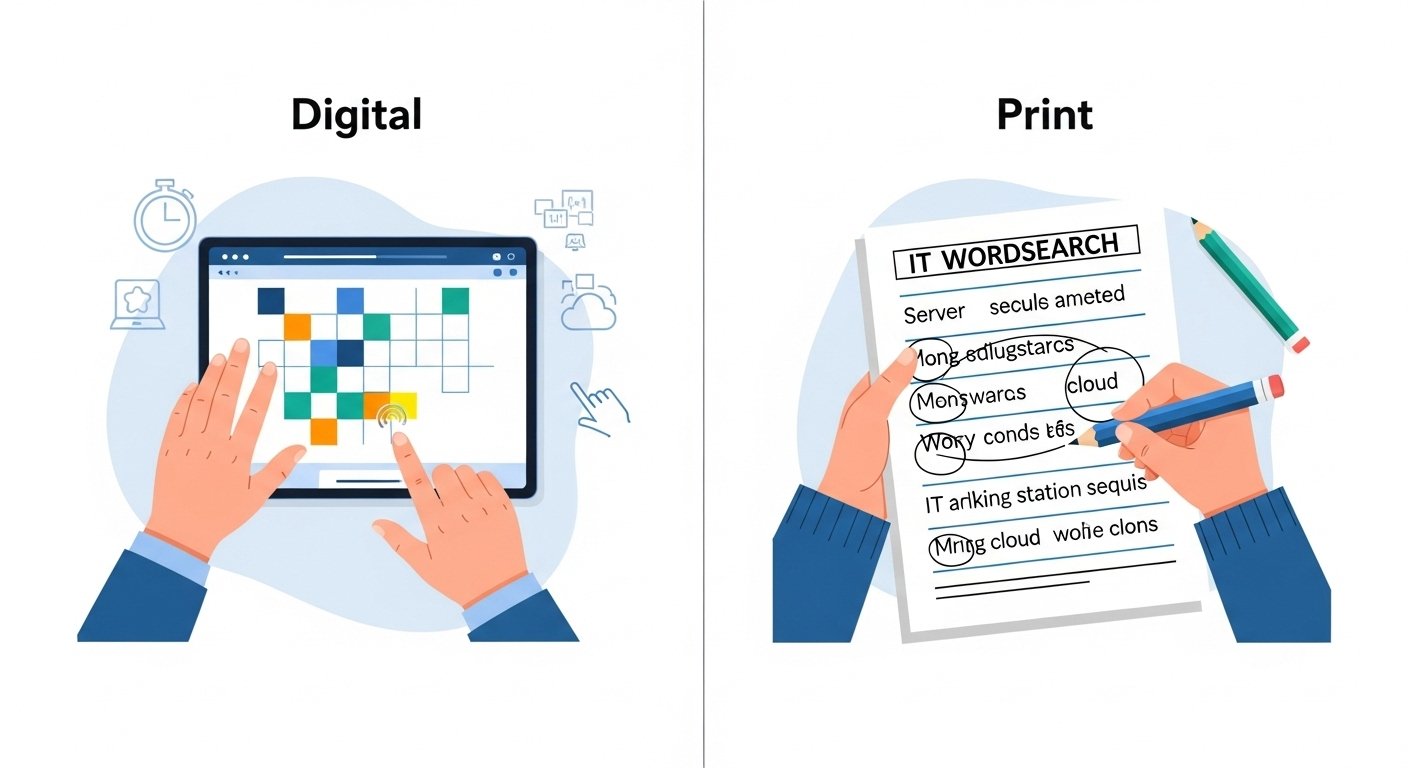
When it comes to solving an IT Wordsearch, players often wonder whether digital puzzles or print worksheets are the better option. Both formats have unique advantages and are used in different settings, from classrooms to mobile apps. Understanding the pros and cons of digital puzzles compared to traditional paper versions can help you choose the format that best fits your needs.
The Benefits of Digital IT Wordsearch
Digital word searches are part of the growing trend of interactive learning tools and e-learning resources. With just a phone, tablet, or computer, players can enjoy mobile puzzle games anytime and anywhere. This convenience makes digital versions especially popular for students and professionals who are always on the go.
Some key advantages of tech-based games include:
Convenience of mobile puzzles – Play on apps or websites without needing a printer.
Accessibility of puzzles – Adjustable difficulty levels, hints, and timer options make them suitable for beginners and advanced players.
Engagement – Animated effects, sound, and instant scoring create a fun, gamified experience.
Learning outcomes from puzzle types – Students often retain information better when puzzles are paired with digital interactivity.
Teachers also prefer digital classroom puzzles because they can integrate them into online learning platforms, track progress, and assign activities remotely. This makes them ideal for virtual or hybrid classrooms.
The Advantages of Print IT Wordsearch
On the other hand, traditional worksheets still hold strong appeal. Many learners enjoy the tactile feel of using a pencil or highlighter on paper. In classrooms, printed puzzles are often easier to distribute, especially when technology is limited or unreliable.
Benefits of offline activities include:
Classroom use of printed puzzles – Great for group work, icebreakers, and low-tech teaching environments.
Focus and attention – Without screen distractions, students often engage more deeply in solving.
Accessibility of paper vs. online – No need for devices or internet access, making them suitable for all learning environments.
DIY customization – Teachers can create classroom worksheets and photocopy them quickly for multiple groups.
Printed IT Wordsearch worksheets are also excellent for younger children, as they help improve handwriting, focus, and patience without relying on digital tools.
Which Puzzle Format Is More Effective?
So, which is better – digital vs. print IT Wordsearch? The truth is, both formats are valuable, but their effectiveness depends on context.
Digital puzzles are best when flexibility, engagement, and interactive features are priorities.
Print puzzles are better for classrooms with limited tech, or when teachers want students to focus without digital distractions.
For example, a teacher might use printed worksheets during in-class activities but assign mobile puzzle games as homework through an online learning platform. This combination allows students to enjoy the best of both worlds.
Fun and Creative Uses of IT Wordsearch
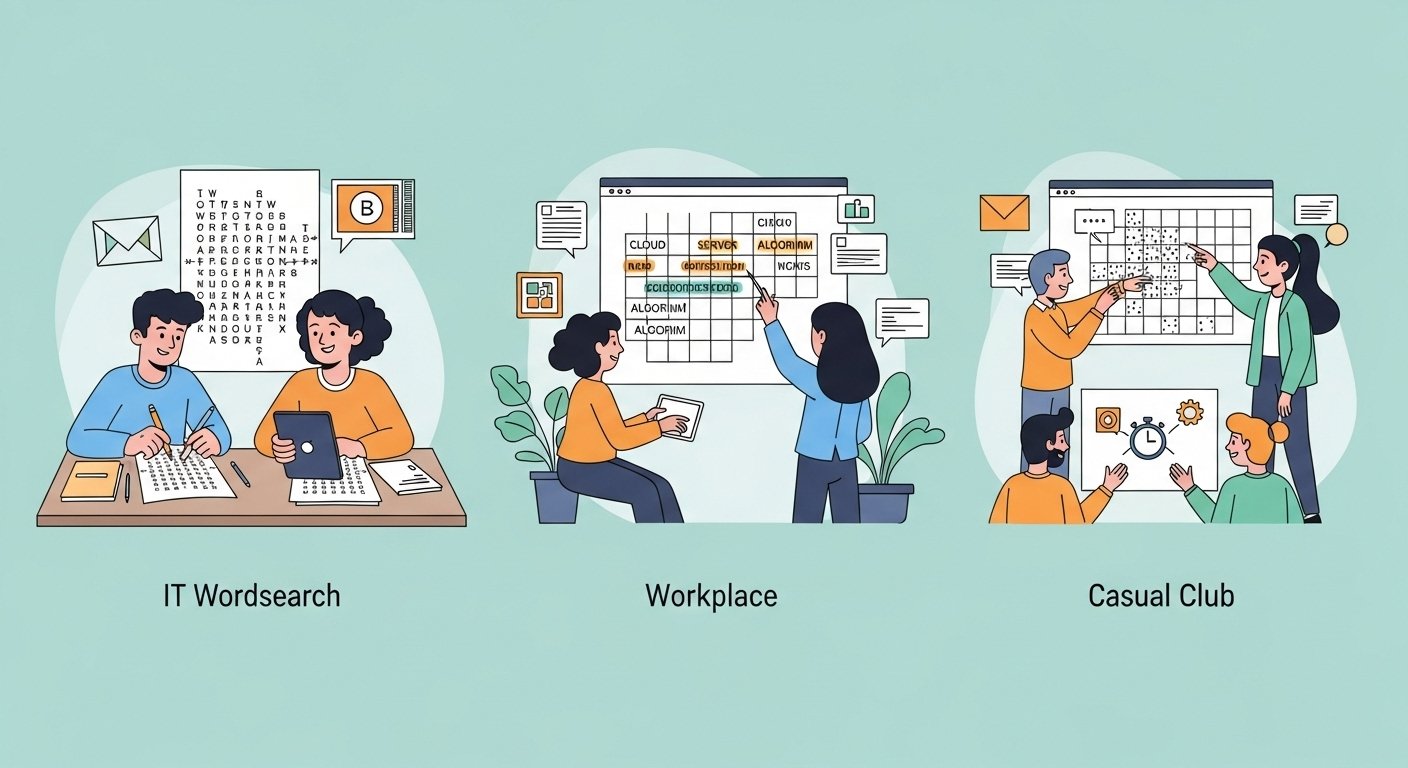
An IT Wordsearch is not just a simple game—it can be a powerful tool for learning, engagement, and even workplace fun. Whether in a school classroom, a corporate office, or an online training session, word searches bring people together while making learning enjoyable. By turning education into a game, they encourage focus, problem-solving, and teamwork in a playful way.
Classroom Icebreakers and Learning Tools
Teachers often use classroom icebreakers to make students feel comfortable and motivated. An IT Wordsearch works perfectly for this. For example, at the beginning of a computer science class, students can solve a puzzle filled with coding vocabulary lists or networking terms. This fun activity not only relaxes the classroom environment but also introduces key concepts in a simple way.
Some creative uses in education include:
Fun activities in the classroom – Quick 5-minute puzzles before lessons to spark curiosity.
Gamifying IT learning – Students earn points or badges by solving puzzles faster.
Engaging students with puzzles – Using puzzle-based team games for group collaboration.
Interactive teaching methods – Incorporating puzzles into e-learning platforms for practice.
These fun educational games make complex IT terms less intimidating and easier to remember.
Corporate Puzzle Games and Team-Building
In the workplace, puzzles can be more than just a brain break. Many companies use corporate puzzle games and puzzle competitions as part of team-building with puzzles. During training sessions, an IT Wordsearch can be designed with terms related to cybersecurity, software tools, or company-specific jargon. This approach not only tests knowledge but also boosts collaboration.
Some examples of workplace applications include:
Training session activities – Use puzzles to review technical terms after a workshop.
Puzzle competitions – Small challenges between teams to encourage problem-solving under pressure.
Puzzles for office fun – Great as ice-breakers during meetings or brainstorming sessions.
Interactive training ideas – Combine word searches with quizzes to reinforce IT knowledge.
These gamified learning activities make training less monotonous and more interactive. Employees engage better when learning feels like a game rather than a lecture.
Creative Puzzle Challenges for All Settings
The versatility of an IT Wordsearch allows it to be adapted for different audiences. In classrooms, teachers might use it for homework or digital assignments. In online learning, educators can design fun puzzles for online learning where students solve them as part of a module. In community or coding clubs, creative puzzle challenges can be organized as contests with small prizes.
Some playful and creative uses include:
Brain break puzzles – Short activities between lessons or tasks to refresh the mind.
Puzzle-based team games – Pair students or employees to solve puzzles collaboratively.
Creative classroom resources – Use themed puzzles around cybersecurity week or coding bootcamps.
Playful ways to teach IT – Teach kids IT terms in a fun, non-technical way through puzzles.
These approaches ensure that puzzles are not only entertaining but also purposeful in boosting knowledge and memory.
Conclusion
An IT Wordsearch is more than just a simple puzzle—it’s a smart way to blend fun with learning. Throughout this article, we explored how these puzzles can be used in classroom worksheets, added to gamified learning activities, or enjoyed as brain training puzzles to sharpen focus and memory. They work equally well for kids, students, and even professionals, making them a versatile tool for both education and entertainment. Whether you prefer offline puzzle activities on paper or interactive mobile puzzle games, the choice depends on what fits your lifestyle and learning needs best.
The beauty of IT Wordsearch lies in its ability to make complex IT terms feel approachable while keeping the experience light and engaging. So, the next time you’re looking for a quick brain break or a creative way to teach, try adding an IT Wordsearch to your routine. Not only will you enjoy the challenge, but you’ll also strengthen your knowledge and problem-solving skills in the process.
Frequently Asked Questions (FAQs)
Is IT Wordsearch suitable for kids and students?
Yes, IT Wordsearch is completely suitable for kids and students. It introduces them to basic IT terms in a playful way, making learning fun while also improving vocabulary and focus. Teachers often use it as an educational activity in classrooms.
Can I play IT Wordsearch offline or online?
You can enjoy IT Wordsearch both offline and online. Printable worksheets are great for classrooms, travel, or family activities, while online platforms and mobile apps offer interactive and on-the-go puzzle solving.
Does solving IT Wordsearch puzzles really improve memory and focus?
Absolutely! Solving wordsearch puzzles acts like brain exercise. It improves concentration, boosts short-term memory, and sharpens pattern recognition skills, which are helpful in both academics and daily life.
How can I create my own IT Wordsearch puzzle for free?
You can easily create one using free online puzzle generators. Just enter your IT word list, choose the grid size, and download the puzzle as a printable worksheet or share it digitally with students and friends.
Are digital IT Wordsearch puzzles better than traditional ones?
Both versions have their benefits. Digital puzzles are interactive and convenient, perfect for mobile learning, while printed puzzles encourage offline engagement, making them ideal for classrooms, family activities, or group challenges.

